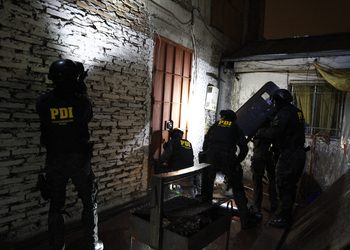For decades, Chile enjoyed an enviable position in South America, seemingly relatively untouched by the violence that organized crime had wrought upon many of its neighbors across the continent.
However, with bomb threats being aimed at courthouses, a stark rise in crimes such as kidnapping, and issues maintaining order within prisons, warning signs have been mounting to suggest Chile’s status as one of Latin America’s “safe” countries is coming to an end.
SEE ALSO: High-Profile Chile Murder Shows Tren de Aragua’s Sophistication
President Gabriel Boric acknowledged the “serious problem” facing the country in a press conference, and announced a new high-security prison for those involved in organized crime after a 48-hour period saw 16 homicides in July.
In the recently released book “A Virus Among Shadows” (“Un virus entre sombras”), Pablo Zeballos, an organized crime consultant and former intelligence official in Chile’s Carabineros police force, analyzes how the loss of faith in the country’s institutions, the influence of transnational criminal organizations, the weaknesses within its prison system, and other factors are driving a decline in security.
InSight Crime spoke with Zeballos to discuss the changes happening in the country’s criminal landscape.
InSight Crime (IC): The book focuses on the changes in criminality in Chile. What are they and what has caused those shifts?
Pablo Zeballos (PZ): I believe that the driving force behind the changes has been the importance of drug traffickers within the prisons. 20 or 30 years ago, they were very low on the prison ladder because it was believed that they corrupted the population.
But with the large profits from drug trafficking, these actors began to gain importance in the prison world and this then grew beyond the prison walls. As a result, the boundaries between being a thief and being a drug trafficker begin to blur, and the perception that these two crimes can be complementary is growing.
I think crime is also changing in Chile. We are moving from structures with territorial links to structures with functional links. That is to say, it no longer matters where you come from, but what your speciality is in order to contribute to the organized criminal enterprise.
IC: The book draws a connection between the protests that began in 2019 in response to complaints about social inequality and the changes in criminal dynamics in Chile. How do you explain that?
PZ: Since before the protests, Chile had been experiencing a chain of events that were delegitimizing institutions, including police and military institutions, especially in cases of corruption. In addition to that, politics as a mechanism to manage social demands was not working either due to a loss of legitimacy in the eyes of the Chilean people. Then, when the protests broke out, a great part of the violence we saw reflected on the streets meant the withdrawal of the police from neighborhoods. That is to say, the police lost prestige due to human rights violations, which meant that they moved out of the places they were supposed to keep safe because they were rejected by the communities.
This was then compounded by looting and robbery dynamics that were more associated with criminal structures than the population. Then came the pandemic, which further pushed state representatives off the streets, obviously not only in Chile, but in a large part of the region. This was very cleverly exploited by organized crime structures, specifically drug trafficking and other illicit markets that occupied those spaces that the state was ceding.
IC: What has been the impact of the arrival and growth of transnational groups in Chile?
PZ: The entry of these groups into Chile came with dynamics that Chilean criminals weren’t used to.
For example, the Venezuelan criminal group Tren de Aragua has popularized territorial power, but through controlling that territory it has diversified its criminal activities.
SEE ALSO: 3 Reasons Why Security Has Deteriorated in Northern Chile
Normally in Chile, an organization that controlled territory did so to manage drug dealing, but Tren de Aragua has shown that in the same area it can diversify multiple criminal activities such as extortion, sexual exploitation, or informal loans.
This has shown Chilean criminals that by dominating territory they can develop multiple, interconnected illicit markets and also generate local money laundering logics that are more difficult to detect. This has been accompanied by excessive and irrational violence that constantly challenges the presence of the state. Chilean criminals are also going to have to adapt to this.
IC: In terms of control inside the prisons, which is the responsibility of the Gendarmería, is there anything specific that the authorities should do that they haven’t already tried?
PZ: I think the Gendarmería has to work quickly on modifying its classification system to be able to better segment criminals. We have a system that is made with parameters that are probably obsolete in the face of the new criminality. Especially because it does not take into account factors such as crime groups coming from abroad and the dynamics of cooperation between groups with a presence in countries such as Central America or even Venezuela and Colombia.
It is necessary to better classify the criminals who enter the prison system and separate those who are associated with criminal structures from those who aren’t. The great challenge for Chile is to prevent prisons from becoming a recruitment center for criminals in order to create a mega-structure, whether it be Chilean or “hybrid,” that is, made up of both Chileans and foreigners.
Featured Image: Chilean Investigative Police (Policía de Investigaciones de Chile – PDI) in the middle of a security operation. Credit: PDI.
Source link : http://www.bing.com/news/apiclick.aspx?ref=FexRss&aid=&tid=66c9212b9a1346db97454e1cd87600b2&url=https%3A%2F%2Finsightcrime.org%2Fnews%2Fex-intel-official-explains-chiles-organized-crime-explosion%2F&c=132408145969625696&mkt=en-us
Author :
Publish date : 2024-08-22 05:22:00
Copyright for syndicated content belongs to the linked Source.
